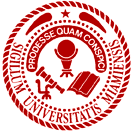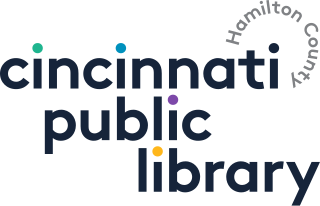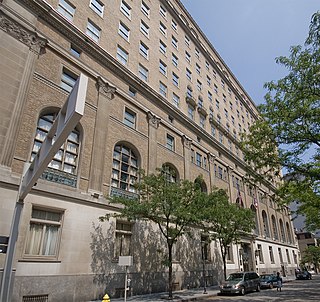
Miami University is a public research university in Oxford, Ohio. The university was founded in 1809, making it the second-oldest university in Ohio and the 10th oldest public university in the United States. The school's system comprises the main campus in Oxford, as well as regional campuses in nearby Hamilton, Middletown, and West Chester. Miami also maintains an international boarding campus, the Dolibois European Center in Differdange, Luxembourg. It is classified among "R2: Doctoral Universities – High research activity".

Lane Seminary, sometimes called Cincinnati Lane Seminary, and later renamed Lane Theological Seminary, was a Presbyterian theological college that operated from 1829 to 1932 in Walnut Hills, Ohio, today a neighborhood in Cincinnati. Its campus was bounded by today's Gilbert, Yale, Park, and Chapel Streets.

Cincinnati and Hamilton County Public Library (CHPL) is a public library system in the United States. In addition to its main library location in downtown Cincinnati, Ohio, CHPL operates 40 regional and branch locations throughout Hamilton County.

Clifton is a neighborhood in the north central part of Cincinnati, Ohio, United States. The population was 8,408 in the 2020 census.

The Athenaeum of Ohio – Mount St. Mary's Seminary of the West, originally St. Francis Xavier Seminary, is a Catholic seminary in Cincinnati, Ohio. It is the third-oldest Catholic seminary in the United States and was established by Edward D. Fenwick, the first Bishop of Cincinnati, in 1829 along with The Athenaeum, which opened in 1831 in downtown Cincinnati.

The Contemporary Arts Center (CAC) is a contemporary art museum in Cincinnati, Ohio and one of the first contemporary art institutions in the United States. The CAC is a non-collecting museum that focuses on new developments in painting, sculpture, photography, architecture, performance art and new media. Focusing on programming that reflects "the art of the last five minutes", the CAC has displayed the works of many now-famous artists early in their careers, including Andy Warhol. In 2003, the CAC moved to a new building designed by Zaha Hadid.

The Phoenix Building and Cincinnati Club are two historic buildings in downtown Cincinnati, Ohio, United States. The membership of these two clubs was chiefly Jewish.

The St. Louis Mercantile Library, founded in 1846 in downtown St. Louis, Missouri, was originally established as a membership library, and is the oldest extant library west of the Mississippi River. Since 1998 the library has been housed at the University of Missouri-St. Louis as a Special Collections library within the Thomas Jefferson Library. The majority of library materials can be assigned to one of four categories: the General (Core) Collection, the John W. Barriger Railroad Library, the Herman T. Pott National Inland Waterways Library, or the Art Museum. The collections of the St. Louis Mercantile Library have been named a City Landmark by the city of St. Louis, Mo., due to the cultural significance of the library.

Calvin Ellis Stowe was an American Biblical scholar who helped spread public education in the United States. Over his career, he was a professor of languages and Biblical and sacred literature at Andover Theological Seminary, Dartmouth College, Lane Theological Seminary, and Bowdoin College. He was the husband and literary agent of Harriet Beecher Stowe, author of the best-seller Uncle Tom's Cabin.

CUF is a neighborhood in Cincinnati, Ohio. Its name is derived from the communities of Clifton Heights, University Heights, and Fairview. CUF is bordered by the neighborhoods of Clifton, the University of Cincinnati, Mount Auburn, Over-the-Rhine, and Camp Washington.

Walnut Hills is a neighborhood in Cincinnati, Ohio, United States. One of the city's oldest hilltop neighborhoods, it is a large diverse area on the near east side of Cincinnati. Eden Park is the gateway to Walnut Hills when driving north from downtown, and the University of Cincinnati is less than 10 minutes away. The neighborhood is redeveloping, restoring many of its buildings and introducing new businesses to the area. The population was 6,344 in the 2020 Census.
The Mercantile Library Association (1820-1952) of Boston was an organization dedicated to operating a subscription library, reading room and lecture series. Members included James T. Fields and Edwin Percy Whipple. Although the association had a relatively long history, its heyday occurred in the mid-19th century, particularly the 1840s and 1850s.

Downtown Cincinnati is the central business district of Cincinnati, Ohio, United States, as well the economic and symbiotic center of the Cincinnati metropolitan area. It also contains a number of urban neighborhoods in the low land area between the Ohio River and the high land areas of uptown. These neighborhoods include Over-the-Rhine, Pendleton, Queensgate, and West End.
God's Bible School and College is a Bible college in Cincinnati, Ohio, founded in 1900. It is of the Wesleyan-Arminian (Methodist) tradition.
The Institute Library is a membership library in New Haven, Connecticut. Founded in 1826 in the tradition of Mechanics' Institutes, it is New Haven's oldest community library and one of the few membership libraries now remaining in North America. The organization was active during the 19th century as a center for lectures, debates, and classes in New Haven.
The Formica Building is a mixed-use building in Cincinnati, Ohio.
The Greater Cincinnati Chamber of Commerce, doing business as the Cincinnati USA Regional Chamber, is a regional chamber of commerce. It is one of the nation's largest chambers of commerce, representing 4,000 businesses and nearly over 500,000 employees in southwestern Ohio, northern Kentucky and southeastern Indiana, also known as Greater Cincinnati, or the Cincinnati–Northern Kentucky metropolitan area. It was twice named national Chamber of the Year.
The following is a timeline of the history of the city of Cincinnati, Ohio, USA.
Robert Clarke & Company was a book publishing company and bookseller in Cincinnati, Ohio, from 1858 to 1909. After 1894, it was known as The Robert Clarke Company. It published literary and historical works.












